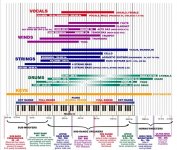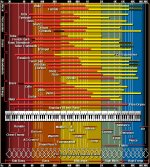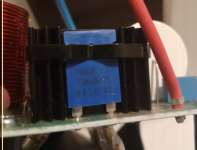The more I think about that measurement, the more I think something isn't quite right. Maybe it's the measurement method or maybe it's something else, but a ported 6.5" driver should be going a little lower that what is shown. And now reading the actual review suggests the same.
Best I can come up with if it isn't a lack of bass is maybe you need more output from about 150/175Hz to about 550Hz. Attached are a couple of charts that may or may not help you identify specific frequencies and certain instruments.
Best I can come up with if it isn't a lack of bass is maybe you need more output from about 150/175Hz to about 550Hz. Attached are a couple of charts that may or may not help you identify specific frequencies and certain instruments.
Attachments
I’m not sure I can trust the graph as it is. There are two strange things that caught my attention.So I thought it might be useful to look at some measurements for your current speakers. Attached below is what I found from a Soundstage review.
1) The downside slope from 100 to 500 Hz is a clear sign that in this region the measure is near field and not corrected for baffle step. If corrected for BS it is actually flat.
2) As a further proof of this is that the impedance graph shows that the tuning is at around 55Hz, and the FR shows a dip at that same frequency. I read this as that the port output is not taken into consideration, so the F3 and F6 points aren’t where they appear here.
So I can’t conclude anything from the bass lack POV, but I suspect a bass slightly lower in SPL than the mid or high-mid and a lack of low bass.
What I see is a rise from 5Khz, the tizz effect.
Ralf
So I thought it might be useful to look at some measurements for your current speakers. Attached below is what I found from a Soundstage review.
As chris661 said previously, boom-tizz indeed, except sort of without the boom. F3 doesn't look to be much higher than about 75Hz depending on what other frequency you are comparing it to. And the rise in response from about 300Hz to 100Hz makes me think that the lack of bass presence that you think you lack is actually just a lack of bass. Or maybe midrange too. But it doesn't look like you are currently missing out on anything centered around 200Hz. Maybe 400-500 is the culprit?
You mention that you have sub(s). Have you tried these speakers with subs filling in the bottom end?
The measurements also make me think that if you listen to something with an actually flat response, it's going to sound dull and somewhat uninteresting to start. Might take a while for your ears to adjust in other words.
I'm glad someone picked up on my post.
Looking at that particular FR curve, I'd say block the port and re-do the crossover.
To reiterate, this would be way cheaper than any of the suggested designs so far, and would give the original poster a good feel for soldering, crossover design and measurements, before launching into an expensive woodworking project.
Chris
Hi chris, i believe you might be right. I just saw yesterday a new version of the bowers 705 s2 signature edition which is to be released within the next week or so, and guess what? its the same speaker with an upgraded crossover... Really got me thinking.. Maybe it wont be the exact speaker that I wanted - but I think if i can tame the sibiliance - I could come a long way.. If the FR is correct, it raises 5db 5-10k isn't that quite alot? Ill do measurments ofc, but it if the rest measures flat, i could more or less keep the values and just pimp up the quality of the components and add an additional of a notch to tame that 5db increase by a couple of dbs to not kill my ears.
+5dB from 5-10kHz will sound "detailed" for 5 minutes in a HiFi showroom, and quickly turn fatiguing after that. That sort of voicing will sell speakers, but won't let the owner keep them.
B&W often use a single cap on their tweeters, meaning they have to roll off pretty high up if the tweeter is to survive a "demo" to their audio-friends. Crossing lower and steeper will almost certainly improve midrange performance, by preventing the woofer from operating in the breakup region.
I'd bet with £100 spent on measurement gear and around £50 spent on crossover parts, you could do something really good with these. The drivers themselves are decent, and I don't understand why B&W don't pair those drivers with a good crossover.
FWIW, I'd try to avoid spending money on super-expensive crossover parts. 250V-rated poly caps will be fine. I get them here: Blue Aran - The UK's no.1 Loudspeaker Component Stockist > Speaker Components > Crossover Components > Capacitors
And they've always worked fine.
Chris
B&W often use a single cap on their tweeters, meaning they have to roll off pretty high up if the tweeter is to survive a "demo" to their audio-friends. Crossing lower and steeper will almost certainly improve midrange performance, by preventing the woofer from operating in the breakup region.
I'd bet with £100 spent on measurement gear and around £50 spent on crossover parts, you could do something really good with these. The drivers themselves are decent, and I don't understand why B&W don't pair those drivers with a good crossover.
FWIW, I'd try to avoid spending money on super-expensive crossover parts. 250V-rated poly caps will be fine. I get them here: Blue Aran - The UK's no.1 Loudspeaker Component Stockist > Speaker Components > Crossover Components > Capacitors
And they've always worked fine.
Chris
So in other words, instead of just trying to notch out the HF overkill, measure the FR and impedance of each driver in cabinet without the xo and try to come up with a new simmed xo that fixes both the top end and the midbass/bass problem too.
If you want to get really adventurous, depending on what results you get from your xo sims, maybe consider turning it into a 3-way by adding something like the 22W (or 2?) in a separate cabinet and crossing over somewhere in the 300Hz area (as a starting point).
Some helpful measurement tutorials:
In-room Quasi Anechoic Measurements
Finding Relative Acoustic Offsets (should work the same in VCAD)
If you want to get really adventurous, depending on what results you get from your xo sims, maybe consider turning it into a 3-way by adding something like the 22W (or 2?) in a separate cabinet and crossing over somewhere in the 300Hz area (as a starting point).
Some helpful measurement tutorials:
In-room Quasi Anechoic Measurements
Finding Relative Acoustic Offsets (should work the same in VCAD)
Yep, precisely.
Going 3-way would be fun, and the additional LF driver(s) could be built into some stands.
That can be V2, though, with V1 just being getting the 2-way system running as well as it can.
I think this could be a really cool project, with excellent results well within reach. If nothing else, they'll definitely look nice.
Chris
Going 3-way would be fun, and the additional LF driver(s) could be built into some stands.
That can be V2, though, with V1 just being getting the 2-way system running as well as it can.
I think this could be a really cool project, with excellent results well within reach. If nothing else, they'll definitely look nice.
Chris
So in other words, instead of just trying to notch out the HF overkill, measure the FR and impedance of each driver in cabinet without the xo and try to come up with a new simmed xo that fixes both the top end and the midbass/bass problem too. .
Hello , I just opened her up, easier said than done...
Looks like decent quality components mundorf caps, however its like yall said, 4,3 uf cap and a 4,5mH inductor giving me hipass of 4625, and a low pass of 285 all first orders. Quite strange. However there were a component i did not recognize ill attatch it
- Status
- This old topic is closed. If you want to reopen this topic, contact a moderator using the "Report Post" button.
- Home
- Loudspeakers
- Multi-Way
- First time DIY - Reality check


